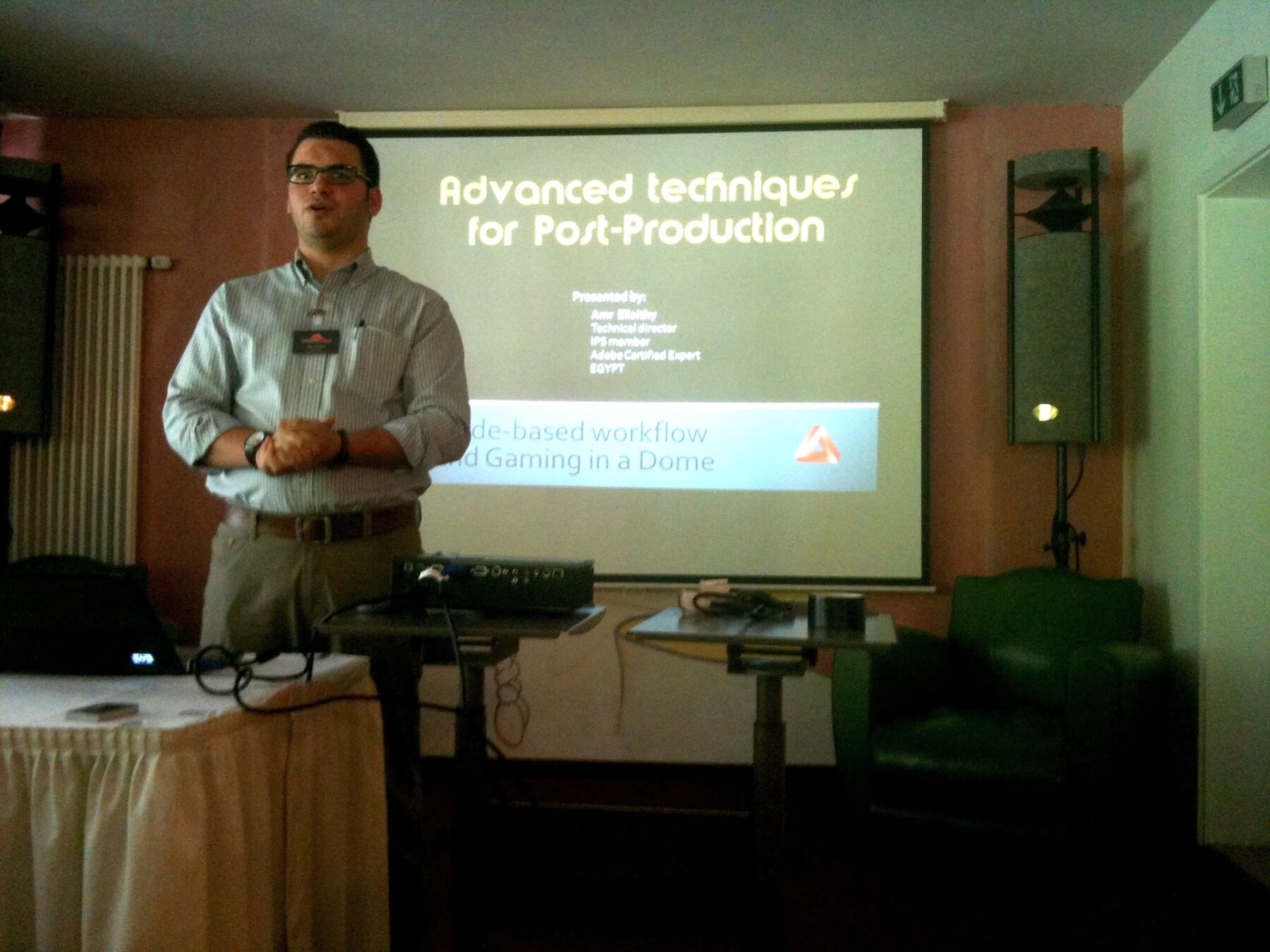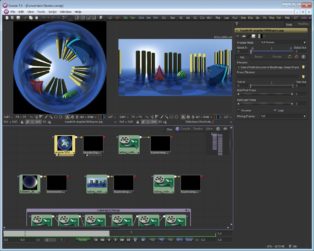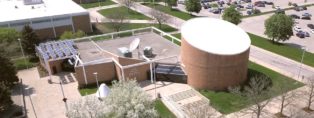2012 FullDome Festival Diary - Day 2
When you have a great day you're happy, but when the next one is even better it means the whole thing rocks!
That's because the 6th edition of the FullDome Festival is not only about screening fulldome shows, it's also about meeting professionals who are involved with fulldome productions and love what they do.
The first to show his motivation and expertise was Amr Ellaithy, technical director and Adobe Certified Expert from Cairo, Egypt. Amr gave an interesting presentation on advanced techniques for post-production, arguing that weather node base processing could better suit the fulldome production workflow when compared to standard workflow- like Adobe After Effects - that are developed on the multiple layers concept.
Amr shared his experience about the making of "Stars of the Stars", a fulldome short produced by his own company that will be screened later on during the Festival. The movie was modeled and animated with Cinema4D, where compositing was made with Nuke, of which Amr is a great fan. He underlined Nuke's features and 3D capabilities built into the software, with no plugins needed at all. Further, the software was also used for the frames' stitching, compositing and color grading. Render times get shorter.

But wait, there's more: Amr and his studios are also looking into creating interactive and immersive games for the fulldome. This opened a very interesting discussion about technical challenges as well as what kind of games might suit our domes. It will probably take advantage of multiple arrays of Microsoft Kinetics hardware, which could be able to engage multiple players at the same time while they try to collect asteroids or draw constellations with their fingers.
There might be an interesting step before the whole thing gets ready, and this might be the case of using this kind of hardware for real time presentations purposes under the dome. Some planetarium vendors already provide the Kinetics hardware to control their systems, but why not to think of a "dome surface" where the presenter could move and rearrange both images, videos, slides, etc in real time?
We'll surely see more in the near future - fulldome augmented reality could be just around the corner!

From Egypt we then moved to California with Tim Florian Horn, a German CG artist who moved to the States and now works at the Visualization Department of the California Academy of Science, which has recently finished their fulldome show: "Life - A Cosmic Story".
With a passionate talk Tim walks us through the steps that allow real science and data to reach the public and get fully understood by the audience. It's clear that this is not an easy task: you need time, great resources and a team who could collaborate with external consultants on different parts of the project.
Rather than just looking up facts at Wikipedia, more than 40 scientists were involved in the production of this show and you can tell that such support made the difference. Bottom line is: ask the real scientists, they will be happy to help!
The show’s dark matter animation was actually rendered in fulldome format directly by the scientists themselves, which means there are now research institutions out there that know out to render fulldome data as well!
The production of the show lasted for 15 months, which went up to 2 years because of the time needed to get the budget funded. The production team was made up of 6 people, even though up to 14 freelancers were also brought aboard for specific tasks.
Tim's presentation raised an interesting - yet original - discussion about how any show's narration could actually ruin the whole experience, rather than enhancing it. The fulldome media itself fills our senses and a few were concerned about how distracting an external voice might be. Our call on this is that each project aims to achieve different goals, and both the narration, the visual effects and the soundtracks are just ingredients you can use to create exactly what you are aiming for: there won't be a unique choice.
Then Tim said, "it's time for a coffee", even though in Germany it might be actually easier to find a beer!
After the break we are back under the dome for the next 10 shows of the day.
Moles - What is Out There?, by Antares FullDome Productions. It's a story of Plato, a cute mole who is as curious as an explorer could be. Both the characters and the animations are great even for little kids, who will learn about how the Earth moves around the Sun, the Moon phases and light pollutes the sky through great children’s songs!
A step further is taken with Tilt, produced by the Melbourne Planetarium, Australia. You will enjoy a nice story about a girl, his brother and a little robot toy, each with very accurate models as well as rigging and animations. Within minutes they found themselves aboard of a spacecraft and will learn about the Earth's rotation axis and its tilt that is causing the four seasons we have. Guess what the Australian girl says when they fly over Italy? "Pizza"! Still better than saying "Berlusconi", I guess!
Next is 8 Scoops of the Miky Way, by Aayushi Animation Studio. The show delivers what it promises, a nice overview of our 8 planets. It's not only about looking at some colorful balls orbiting the Sun - where filaments and bright spots were nicely modeled - but it's also about reaching the surfaces of a few of them, such as Mercury and Venus. The latter is shown as seen from the radar observations, which highlights the surface's morphology and gives a better idea of how rocky is this planet. The show ends with a nice sequence giving a global overview of each planets’ scales compared to our Sun.
From a journey through space to a journey through time: A Part of the Sky called Orion, produced by Bays Mountain Productions. We all know where Orion is and how to find it; in fact this show tells us about the mythology associated to this constellation as seen by three very different ancient cultures: the Greek, the Egyptian and the Inupiaq one. Visuals are simple, mostly made of 2D animations, but the story is intriguing and the narration keeps you engaged until the end.
The French show, Vibrato, a production by ART'M Créateurs Associés and Planetarium St. Etienne, belongs to the technical genre, beginning with the seeking of gamma ray bursts and taking us all the way to a unexpected yet nice sequence through a black hole. We hear about wormholes, string theory, multiverses… until we experience the Big Bang, the primary photonic soup, the first galaxy formations as well as the dark matter. What a trip for general relativity enthusiasts!
Still about the universe as a whole is Life - A Cosmic Story, by the California Academy of Sciences. Early on we learnt about how the visuals come from simulations, rather than animations, and the final output is great. Within the first three minutes we pass from a forest, fly into a leaf and find ourselves looking at dark matter straighter! The show delivers also a beautiful volumetric model of the Milky Way. The volcanic island scene is just amazing, and when we go to Mars we can appreciate the planet itself visualized as it would be with water on it. Details are definitely taken care of with fine detail and the final piece rocks.
Again a show from the USA, Undiscovered Worlds, produced by the Boston Planetarium and which begins with a great scene in an imaginary planet somewhere in our Universe. The show is all about extrasolar planets and tells us how we find them as well as how we might see them if we could travel that far. Camera movements are very nice and the way the first solar system appears is also very clever. Thanks to a nice animation, the planetary transit method is also well explained. Worth mentioning is also the final scene with a camera movement zooming out from Earth to outer galaxies.
The next show tells us all we need to know about stars: Secret Life of Stars, by Evans & Sutherland. The intro is filled with an epic soundtrack which brings us to funny healines on some sort of galactic newspaper. The narration is very passionate and keeps you engaged until the end. We learn about stellar evolution - red giants, blue giants, white dwarfs, neutron stars, etc. - as well as planetary' formation. We also hear about Mira and binary systems while looking at beautiful scenes that explain the facts about their dynamics.
Awesome light: Chasing Celestial Mysteries by Sky-Skan and the Imiloa Space and Astronomy Center brings us to Mauna Kea, the sacred mountain where lots of telescopes are now fully working. The show delivers great time lapse sequence with beautiful colors and details of the island as well as all the telescopes, both from outside and inside their domes. The animation of the main asteroid belt is great, just like the reconstruction of our galactic plane as acquired through thousands of images through infrared observations. If you are in love with telescopes, you either go to Mauna Kea or you go to see this show!
Last but not least is the show from the Adler Planetarium, The Searcher. You might wonder, the searcher of what? The searcher is you, assisting an intergalactic traveler who's looking for his own planet. Once he gets there, he finds out that his ancestors don't live there anymore. In fact the model of this fantasy planet is very different - yet very beautiful - from ours. No need to say that the Searcher will find his way to the Earth, and the storytelling just makes you feel you're either reading or watching Carl Sagan's "Cosmos." In fact, the show is dedicated to Sagan’s memory and his own son was involved with the production as well.
You would probably agree that remembering Carl Sagan is the best way to terminate the day at the festival but it went even better! You wonder why?
Well, just hold on and stayed tuned for the next issue of our FullDome diary ;)
Have you liked this post? Subscribe to FDDB Newsletter
Sign up now, it's free!


















